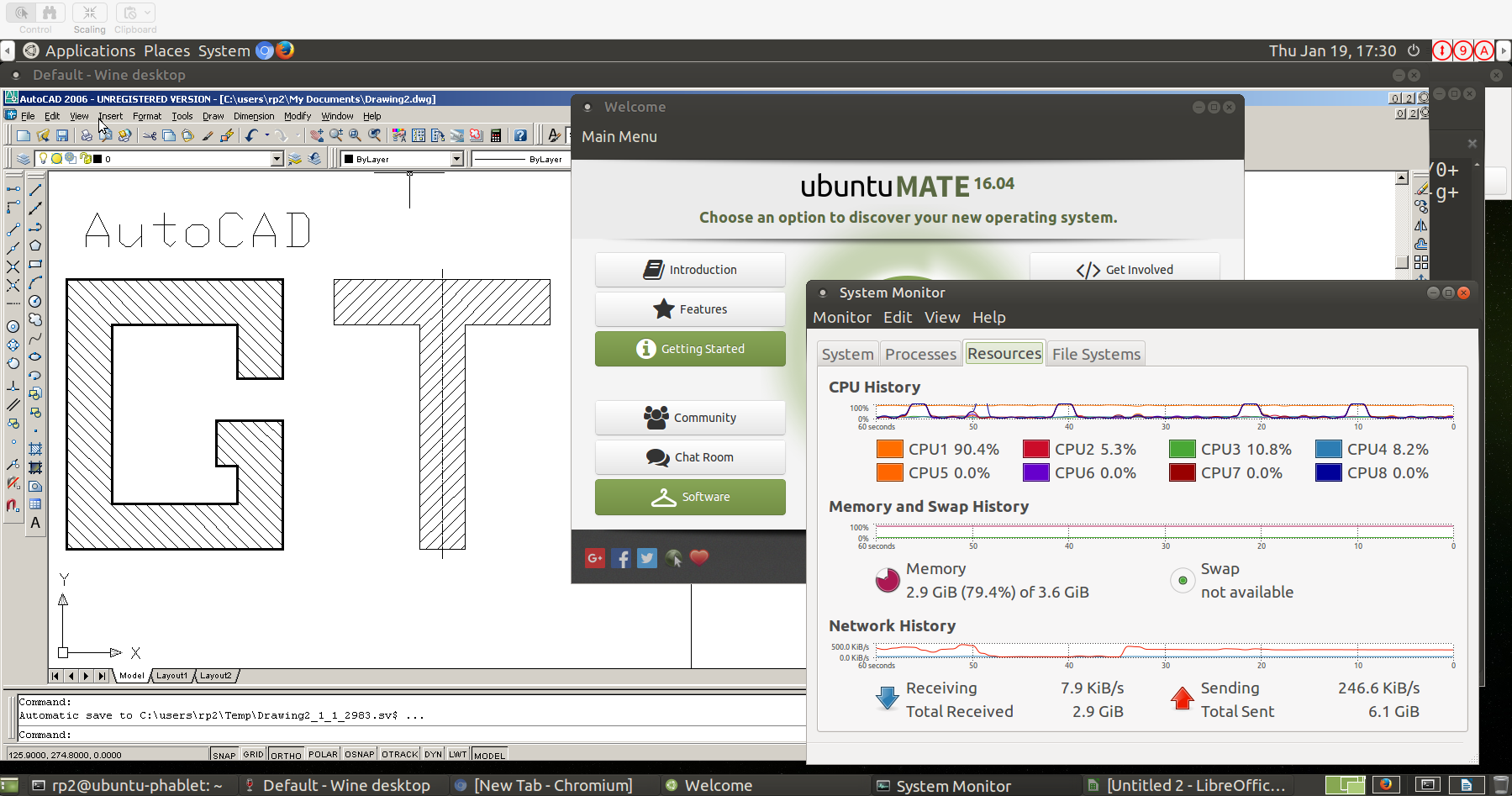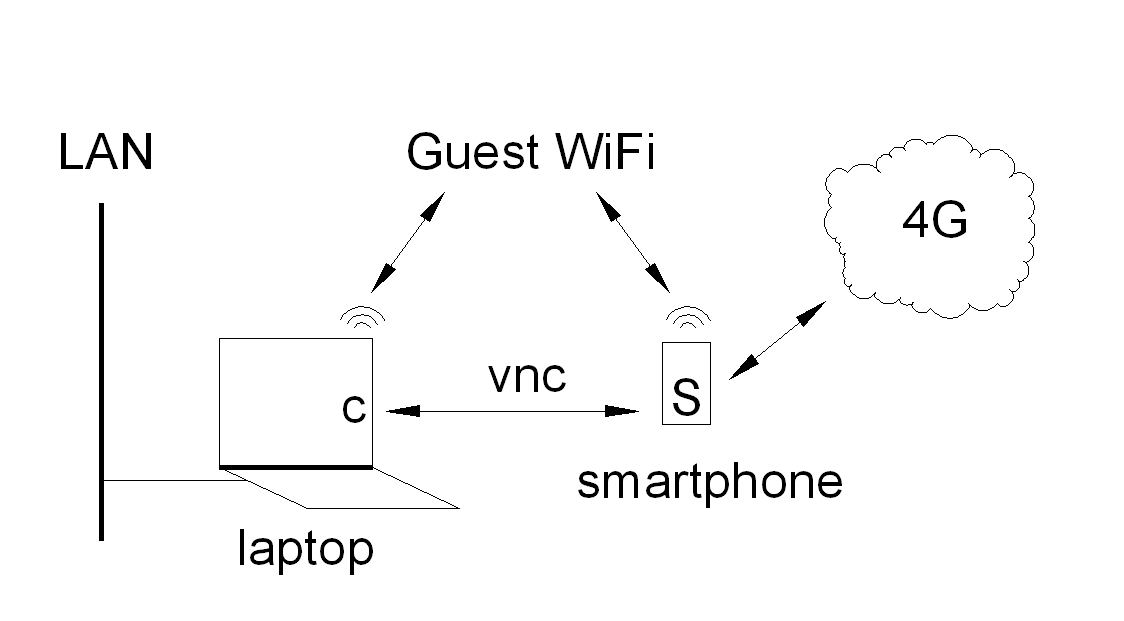Using the smartphone Meizu Pro 5 Ubuntu Edition for other purposes
This is not a review of the smartphone or operating system Ubuntu Touch, on which it works, but rather a description of how to use a set of Linux technologies on a smartphone for certain tasks (for which a laptop or desktop computer is commonly used).

About six months ago (on his birthday), the Meizu Pro 5 smartphone was purchased in a top configuration. In the very first week, the Chinese Android Flyme was demolished, and the Ubuntu Touch OTA-12 OS was installed. I will say right away that the operating system at that time (and even now too) is still raw, but the smartphone functions as a telephone regularly. Calls, sms, distribution of 4G internet to a laptop via WiFi - everything works.
Around the same time, Raspberry Pi 3 was configured with Ubuntu Mate - and experiments were conducted on using it as a home desktop computer, which, unfortunately, were not successful - on the one hand, Pi 3 turned out to be weak, and I wanted to have something This is a type of personal laptop - as a working laptop (provided by an employer, with whom you travel without leaving) and a working iPhone are used only for business needs.
As a result, the microSD card installed by Ubuntu Mate migrated to the Meizu Pro 5 smartphone and was mounted in the / home / phablet / PI folder and then using a simple command, the VNC server was raised in a chroot environment.
Thus, at any time you can connect to the Ubuntu Mate desktop using the vncviewer or Microsoft RDP Client from a laptop or any other device (for example, iPhone). And if you connect a Bluetooth keyboard and mouse to Meizu Pro 5, and run vncviewer from a Libertine container, you can use the Ubuntu Mate desktop directly on your smartphone (a very small image, but for emergency cases, it is fine).
The smartphone’s resources are about twice as large as those of the Raspberry Pi 3 - 8 cores, 4 Gb of RAM - so all “office” applications work fine. LibreOffice (this article is now written using Writer), Chromium, Firefox, GIMP, Inkscape, Keepass2, and so on.
Of course, terminal applications are all present - mate-terminal, konsole, xterm, etc. VPN with two-factor authentication (openconnect) - from the chroot environment - also works.
Windows applications. As it turned out, this is also possible.
PL / SQL Developer (+ Oracle Instant Client) and AutoCAD work through wine and Exagear (i686 emulation). And quickly enough - this GT drawing was created in AutoCAD on a smartphone in 5 minutes - it's comfortable to draw!
Microsoft Office (2007) - starts and runs, installed in case of emergency, if Libre Office fails.

Upgrading operating systems — both Ubuntu Touch and Ubuntu Mate — are done with apt-get.
Below is a description of some handy things that have been tried.
Since sms are stored in the sqlite database, you can select sms using SQL, for example:
and then through the conveyor feed the script to send:
You may not know which pocket your smartphone is in, or in which room your spouses have a laptop, but if they are on the same network, you can access the phone via ssh and copy the pictures to the laptop:
Especially valuable documents and Keepass with passwords lies in the mounted Cryptkeeper folder.
Works with the help of the Microsoft Wireless Display Adapter (Miracast) - USB-receiver is connected to a TV or monitor. At the same time, Ubuntu Touch switches to Desktop mode, all phone applications become separate windows on the desktop. It is rarely used, because the image quality is suitable only for viewing videos, and working with small text is very unpleasant - for this, vncviewer is used from a laptop.
It works quite normally, sometimes it is used to connect the iPhone to talk on Skype, or connect a laptop to the Internet via WiFi.
If there is a desire not to waste the employer's Internet traffic (during working hours while on the local network), you can delete the default gateway to Guest WiFi on the phone, and then all network activity will occur on the 4G network, and the display will be performed on the laptop screen via vnc (or xrdp).

The connection is established using a USB-C-USB adapter, to which a USB hub can be connected, and a mouse, keyboard, etc. can be connected to it.
Samsung color laser printer was found in the home WiFi network and automatically installed using CUPS, documents are printed properly.
Who likes mplayer, you can start playing music in the console:
And in another tab of the console - the mixer (volume control)
TortoiseHg is used, the main repository is on a smartphone, repository clones are made on several home computers / laptops. For synchronization on the smartphone, the Web server is started using TortoiseHg Workbench.
The smartphone can work for several days on a single charge, about 2 times longer than the iPhone (not exactly measured, my subjective opinion) - which is quite pleasing. In addition, he can share the charge with another phone through a USB-C-USB adapter.
The gap in performance between smartphones and computers a decade ago is gradually reduced, so most of the tasks that were performed on personal computers can now be performed on smartphones.
If you have questions, ready to answer in the comments.

About six months ago (on his birthday), the Meizu Pro 5 smartphone was purchased in a top configuration. In the very first week, the Chinese Android Flyme was demolished, and the Ubuntu Touch OTA-12 OS was installed. I will say right away that the operating system at that time (and even now too) is still raw, but the smartphone functions as a telephone regularly. Calls, sms, distribution of 4G internet to a laptop via WiFi - everything works.
Around the same time, Raspberry Pi 3 was configured with Ubuntu Mate - and experiments were conducted on using it as a home desktop computer, which, unfortunately, were not successful - on the one hand, Pi 3 turned out to be weak, and I wanted to have something This is a type of personal laptop - as a working laptop (provided by an employer, with whom you travel without leaving) and a working iPhone are used only for business needs.
As a result, the microSD card installed by Ubuntu Mate migrated to the Meizu Pro 5 smartphone and was mounted in the / home / phablet / PI folder and then using a simple command, the VNC server was raised in a chroot environment.
Thus, at any time you can connect to the Ubuntu Mate desktop using the vncviewer or Microsoft RDP Client from a laptop or any other device (for example, iPhone). And if you connect a Bluetooth keyboard and mouse to Meizu Pro 5, and run vncviewer from a Libertine container, you can use the Ubuntu Mate desktop directly on your smartphone (a very small image, but for emergency cases, it is fine).
The smartphone’s resources are about twice as large as those of the Raspberry Pi 3 - 8 cores, 4 Gb of RAM - so all “office” applications work fine. LibreOffice (this article is now written using Writer), Chromium, Firefox, GIMP, Inkscape, Keepass2, and so on.
Of course, terminal applications are all present - mate-terminal, konsole, xterm, etc. VPN with two-factor authentication (openconnect) - from the chroot environment - also works.
Windows applications. As it turned out, this is also possible.
PL / SQL Developer (+ Oracle Instant Client) and AutoCAD work through wine and Exagear (i686 emulation). And quickly enough - this GT drawing was created in AutoCAD on a smartphone in 5 minutes - it's comfortable to draw!
Microsoft Office (2007) - starts and runs, installed in case of emergency, if Libre Office fails.

Upgrading operating systems — both Ubuntu Touch and Ubuntu Mate — are done with apt-get.
Below is a description of some handy things that have been tried.
Redirect SMS if necessary (with filters and sorting)
Since sms are stored in the sqlite database, you can select sms using SQL, for example:
phablet@ubuntu-phablet$ echo "selecttimestamp, message from text_events where message like'Example%'orderbytimestamp; " | sqlite3 /home/phablet/.localhost/share/history-service/history.sqliteand then through the conveyor feed the script to send:
/usr/share/ofono/scripts/send-sms/ril_1 555555555 $message_string 0Copying photos, videos and other files on sftp (from phone and to phone)
You may not know which pocket your smartphone is in, or in which room your spouses have a laptop, but if they are on the same network, you can access the phone via ssh and copy the pictures to the laptop:
phablet@ubuntu-phablet$ scp -p *.jpg laptop:/Users/wife_login/Pictures/File Encryption
Especially valuable documents and Keepass with passwords lies in the mounted Cryptkeeper folder.
Connecting an external monitor / TV
Works with the help of the Microsoft Wireless Display Adapter (Miracast) - USB-receiver is connected to a TV or monitor. At the same time, Ubuntu Touch switches to Desktop mode, all phone applications become separate windows on the desktop. It is rarely used, because the image quality is suitable only for viewing videos, and working with small text is very unpleasant - for this, vncviewer is used from a laptop.
Internet distribution from the smartphone
It works quite normally, sometimes it is used to connect the iPhone to talk on Skype, or connect a laptop to the Internet via WiFi.
Separation of personal and business Internet traffic
If there is a desire not to waste the employer's Internet traffic (during working hours while on the local network), you can delete the default gateway to Guest WiFi on the phone, and then all network activity will occur on the 4G network, and the display will be performed on the laptop screen via vnc (or xrdp).

Connecting keyboards, mice, USB hard drives, USB drives, printer
The connection is established using a USB-C-USB adapter, to which a USB hub can be connected, and a mouse, keyboard, etc. can be connected to it.
Samsung color laser printer was found in the home WiFi network and automatically installed using CUPS, documents are printed properly.
Console mplayer in the terminal to listen to music
Who likes mplayer, you can start playing music in the console:
user@ubuntu-phablet$ cd Music; mplayer *.mp3And in another tab of the console - the mixer (volume control)
phablet@ubuntu-phablet$ padsp aumixMercurial repository
TortoiseHg is used, the main repository is on a smartphone, repository clones are made on several home computers / laptops. For synchronization on the smartphone, the Web server is started using TortoiseHg Workbench.
Charging another phone from Meizu Pro 5
The smartphone can work for several days on a single charge, about 2 times longer than the iPhone (not exactly measured, my subjective opinion) - which is quite pleasing. In addition, he can share the charge with another phone through a USB-C-USB adapter.
Total
The gap in performance between smartphones and computers a decade ago is gradually reduced, so most of the tasks that were performed on personal computers can now be performed on smartphones.
If you have questions, ready to answer in the comments.
